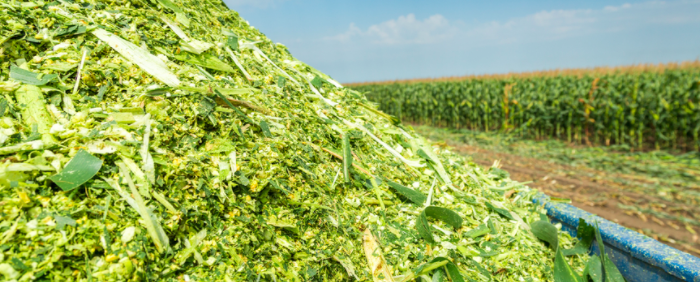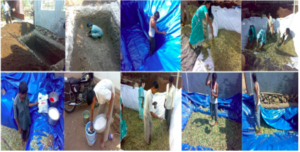
Silage is fermented, high-moisture stored fodder which can be fed to cattle, sheep and other such ruminants (cud-chewing animals) or used as a biofuel feedstock for anaerobic digesters. It is necessary to adopt this method by Indian dairy farmers on large scale in situations like drought or heavy rainfall or scarcity of fodder. Silage making means preservation of chaffed cereal green fodder in anaerobic condition by way of fermentation method. Silage is made either by placing cut green vegetation in a silo or pit, by piling it in a large heap and compressing it down so as to leave as little oxygen as possible and then covering it with a plastic sheet, or by wrapping large round bales tightly in plastic film. Silage can be made from many field crops, and special terms may be used depending on type; oatlage for oats, haylage for alfalfa. Ensilage can be substituted for root crops. Bulk silage is commonly fed to dairy cattle, while baled silage tends to be used for beef cattle, sheep and horses.
Binita Kumari*, Tulika Kumari*, Priyanka Singh**, Priyanka Lal* *Ph.D. Scholar, ICAR-NDRI, Karnal **Ph.D. Scholar, PAU, Ludhiana
Essential fodder crops for silage making
To prepare best quality silage, cereal green fodder like Green fodder maize, Fodder sorghum, Bajara, Hybrid Napier, Sugar cane tops, Oat, Marwel etc are required. Preference for cereal green fodder (monocotyledons) is due to it has more sugar content than protein, as sugar is utilised in fermentation process to make lactic acid by microorganisms. These cereal fodder crops have hard stem, which takes more time for drying in making hay of these crops, so it is better to use these kinds of crops for making silage than hay.
Benefits of silage making
There are numerous benefits of having silage as an animal feed. Few of them are as follows:
- Silage is storage system of green fodder which keeps all parts of fodder in appropriate condition for feeding than any other system of storage of fodder.
- For daily cutting, transporting & chaffing of fodder in traditional way requires more labour &time but in case of silage, fodder cutting, transport, chaffing is done at one time only, so it is less labour & time consuming practice. Land under fodder cultivation is emptied, and immediately it is used for plantation of other crops. So farmers’ can take more crops in same land in a year against traditional way where land is reserved for fodder until all crops is harvested.
- Silage is prepared in closed & air tight condition so there is no danger of fire (In hay making, dry fodder is stocked & exposed for fire like situation).
- Silage requires less space for storage as it is pressed in pit/tank than hay making.
- Due to lactic acid in silage, it is easily digestible to animals, so energy required for digestion is used for other purposes like milk production etc.
- Important thing behind to adopt silage is in scarcity it provide supply of fodder to dairy animals. Situations like drought, high rainfall & scarcity of fodder, farmers may use silage for feeding to dairy animals. (Rain fed area where shortage of green fodder is for March to June & in high rainy area or water logged lands, it is impossible to cultivate or harvest fodder)
- Silage is tasty & flavoured, so it increases appetite of dairy animals.
- Due to treatment of additive for silage, farmers can supply energy, mineral & vitamins to dairy animals.
Silage preparation
Silage is produced through use of pits or trenches, towers and sacks for small quantities. However, pits are mostly used to prepare silage for large dairy units. The silage pit should be located at a place safe from rodents, away from direct sunlight and with higher elevation or slightly sloppy to avoid rain water entering into the facility. The ideal materials used in silage making should have a moisture content of 60 to 70 per cent or dry matter in the range of 30 to 35 per cent (tested by taking a small bundle of the fodder and wringing with two hands and if no moisture comes out, it is ready to ensile) and a pH below 4.2 for wet forage and below 4.8 for wilted forage. In rainy periods when the fodder is too wet, containing more than 70 per cent water, it is advisable to wilt it in the sun first. Crops such as maize, sorghum, oats, pearl millet, and napier grass are very suitable for ensiling (preserve green fodder). They contain fermentable carbohydrates (sugar) necessary for bacteria to produce sufficient organic acid that acts as a preservative. Though leguminous fodders can also be used, they are rich in proteins and low in sugars making them a bit difficult to ensile. Harvesting maize or sorghum for making silage is ideal when their seeds are soft but not milky when squeezed open. Napier grass, on the other hand, needs to be about a metre high while legumes should have young pods, which are not dry. Apart from molasses, other additives like common salt, formic acid, lime or urea can also be used to enable good fermentation process.
- To start, prepare the pit and then place a big polythene sheet on the floor and walls.
- Cover about a metre of walls so that the forage does not come into contact with soil.
- Chop the fresh forage to lengths of about one inch using a chaff cutter.
- Prepare the first layer by emptying the chopped materials into the plastic lined pit to approximately 15cm high, and spread evenly.
- Then dilute molasses with water at a ratio of about 1:2 and sprinkle evenly over the forage layer using a garden water sprayer.
- Compact the layer by trampling on it using clean boots to force out as much air as possible. This will prevent fungi growth and spoilage. Repeat this process of adding bags of chopped forage, diluted molasses while compacting to expel maximum air out of the material until the pit gets filled in a doom shape.
- After the final filling and compacting, wrap the polythene sheet around the silage and cover the top of the heap with a second sheet to prevent water from running into the silage.
- Finally cover the heap with a thick layer of soil of at least 2ft giving special attention to the edges first as you come towards the middle to keep the air out and to prevent damage of the polythene by rain, birds and rodents. With good sheeting and enough soil on it, the silage can be kept for more than one year.
- It takes about 30 to 40 days for the silage to mature and be ready for feeding. Never open the whole silage pit at once.
- Only one end of the narrow side should be opened a bit. Remove enough material for each day’s feeding and cover again. This way air is prevented from entering the silage.
- However, once the pit is opened, use the silage as quickly as possible.
Storing Silage
Silage must be firmly packed to minimize the oxygen content, or it will spoil. Silage goes through four major stages in a silo:
- Presealing, which, after the first few days after filling a silo, enables some respiration and some dry matter (DM) loss, but stops
- Fermentation, which occurs over a few weeks; pH drops; there is more DM loss, but hemicellulose is broken down; aerobic respiration stops
- Infiltration, which enables some oxygen infiltration, allowing for limited microbial respiration; available carbohydrates (CHOs) are lost as heat and gas
- Emptying, which exposes surface, causing additional loss; rate of loss increases.
Feeding cows with silage
A dairy cow is fed depending on the body weight or generally be given about 6kg to 15kg of silage per day. It is advisable not to feed silage immediately before or during milking especially when the quality is poor as the milk can easily take the smell of the feeds. During these times, a cow can be fed fresh grass, hay, legumes and concentrates. After feeding silage, the bunks and corners of the feeding troughs should be cleaned immediately to prevent contamination.
Safety measures
Silos are potentially hazardous. Deaths may occur in the process of filling and maintaining them, and several safety precautions are necessary. There is a risk of injury by machinery or from falls. When a silo is filled, fine dust particles in the air can become explosive because of their large aggregate surface area. Also, fermentation presents respiratory hazards. The ensiling process produces “silo gas” during the early stages of the fermentation process. Silage gas contains nitric oxide (NO), which will react with oxygen (O2) in the air to form nitrogen dioxide (NO2), which is toxic. Lack of oxygen inside the silo can cause asphyxiation. Molds that grow when air reaches cured silage can cause organic dust toxic syndrome. Collapsing silage from large bunker silos has caused deaths. Silage itself poses no special danger.


Thanks for the information. I will try to make silage for my goats.
Thanks for the information. I will try to make silage for my goats. in this dry season it is hard to get fresh grass and others like ipil ipil, napler and the like for goat feeding.